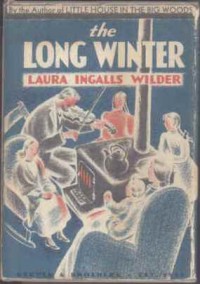The silence was as terrible as cold is

The Long Winter
by Laura Ingalls Wilder
Appropriately, I read the majority of this book on a cold, windy November day, feeling increasingly grateful for central heating and a cupboard well stocked with teabags. Before I carry on, this is book 6 in the Little House series, so this may contain spoilers for the previous titles.
No sooner have the Ingalls family installed themselves in their claim shanty (their littlest house yet) on their brand new Dakota farm that they hope will be their last home, than what should come along but a prediction (and early signs of) a seven-month extra-harsh winter. The shanty is far from weather-proof and they haven’t been able to grow themselves a winter store of supplies yet, so there’s nothing for it but to move into the nearby new town (De Smet) where Pa owns a store building they can live in. The store building is weather-proof and just over the road from shops that can sell them supplies as they need them. And there’s a school in town, so Laura and not-so-little-anymore sister Carrie can go to school and make new friends.
The bulk of the story to this book is: really bad winter, poor family barely scrapes through. But it’s actually pretty gripping. Wilder tells us how monotonous it got eating nothing but potatoes and brown bread and desperately trying to eke out the kerosene by using the lamplight as little as possible, but she doesn’t repeat these details more often than needed.
One way that she manages to bulk out the narrative is by adding in the Wilder brothers as new characters. Obviously we all know that Almanzo Wilder is going to wind up marrying Laura Ingalls – it’s right there in her name on the cover of the book, after all! But I still found it odd that after four books written from the perspective of Laura, we now have scenes following Almanzo’s story, scenes Laura isn’t in at all. The thing is, the narrative is third person, not first, but it’s most definitely not omniscient. We only ever, before this book at least, experience events as Laura experienced them. So, for instance, when Pa meets an Indian when he’s out hunting the panther in Little House on the Prairie, we only hear that story as Pa recounts it to the family when he gets home. But now we get scenes of Almanzo and his brother Royal cooking pancakes and making plans for their own homestead, next door to the Ingalls’ new land. Perhaps if I hadn’t skipped book 2, Farmer Boy, which is about Almanzo’s childhood, this would have been less strange. I’ll probably go back to it.
Incidentally, much is made in this book of Almanzo being 19 years old, which means that he has lied to the officials to make a land claim because the rules say he’d have to be 21. But in real life Almanzo was 24 at this point. Wikipedia suggests this change was made so that the age gap between Laura and Almanzo is only 5 years, which would be more palatable to 20th-century readers than the true gap of 10 years once their romance gets going in later books. Personally I think knowing they were happily married for several decades, until Almanzo’s death, negates any question about the age gap being inappropriate, but I wouldn’t be surprised if the same concern would be raised by a publisher today.
“Everything was still. No wind stirred the grey-bleached grass and no birds were on the water or in the sky. The lake faintly lapped at the rim of that stillness. Laura looked at Pa and she knew he was listening too. The silence was as terrible as cold is. It was stronger than any sound. It could stop the water’s lapping and the thin, faint ringing in Laura’s ears. The silence was no sound, no movement, no thing; that was its terror.”
Published 1940 by Harper & Brothers.
Source: Google Books.